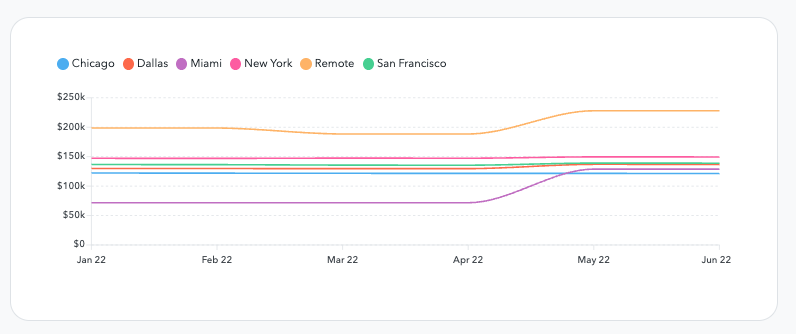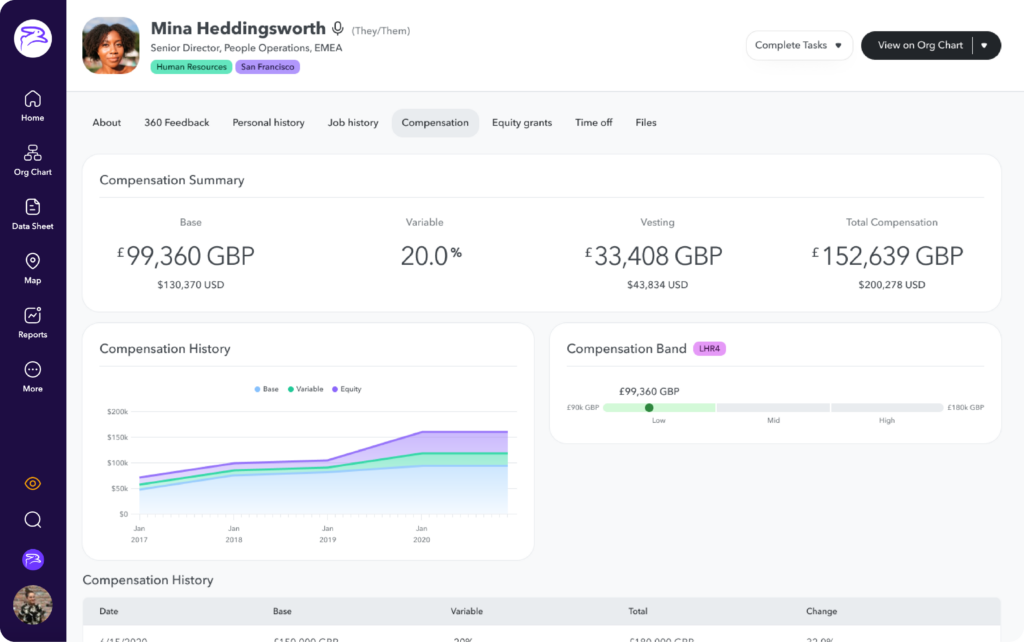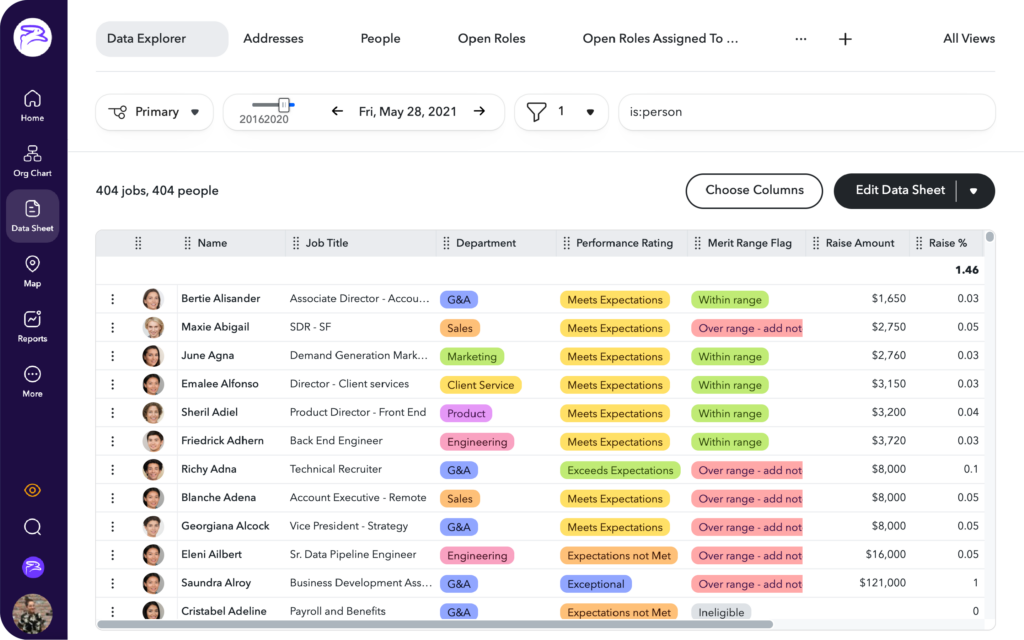
In a world where pay transparency is becoming increasingly important, companies are transitioning to location-based salaries to remain competitive and compliant with salary transparency laws.
As a business leader, it is important to prioritize pay transparency during this transition to ensure fairness for all employees … but deciding on and communicating those changes is easier said than done.
Luckily, there’s best practices when it comes to initiating pay transparency, especially when you employ location-based salaries.
Do you pay a software engineer living in San Francisco the same as an engineer relocating to Kansas City? How do you adjust salaries fairly? And how do you communicate the shift to employees?
These questions have merit. According to PayScale’s cost of living calculator, Kansas City has a cost of living that’s 45% lower than San Francisco and a housing market that’s 72% lower. An average software engineer making $130,000 a year in San Francisco would only need to earn roughly $72,000 to maintain their current standard of living in Kansas City. That’s oversimplifying what goes into the adjustment, but it helps to better understand what a switch to location-based pay might look like.
Whether you’re figuring out how to transition to location-based salaries, or already do so but are working toward pay transparency, it’s critical to have a more informed, responsible compensation strategy.
Ready to get started? Use the following six steps as a guide to creating a more transparent pay structure.
A major reason companies adopt pay transparency – besides salary transparency laws – is to promote fairness and eliminate pay disparity. Therefore, as you adjust pay to reflect your employees’ location, it’s now more important than ever to ensure your practices don’t contribute to existing pay gaps. Luckily, pay analytics can help you identify and monitor those gaps.
In short, pay analytics allow you to break down and view compensation data by specific demographics, such as race, gender, and age. By revisiting these metrics over time, you can see whether you’re making progress toward your pay equality goals.
Of course, location introduces a new metric to the fair pay equation. Whether your company maintains multiple office spaces, was open to remote work pre-pandemic, or experienced a surge of relocated employees over the past few years, visualizing your people by their location can give you insight into how you might approach defining pay locations.

The right software allows you to filter employee salary based on location so you can make informed decisions moving forward.
For example, pre-2020, Slack maintained two pay zones for their U.S.-based employees: New York and San Francisco. Each zone took into account the cost of living expenses for employees. In anticipation of employees relocating outside these zones, Slack expanded pay zones to five in total. “We created these bands in order to provide transparency and fairness to our employees,” says Nadia Rawlinson, Slack’s Chief People Officer.
Ultimately, how you choose to define location will be unique to your operation. If analyzing location data reveals concentrated pockets of employees in certain states or cities, you might approach location-based pay by the cost of living in those areas. However, if you see a broader distribution of employees, you might adopt a regional approach, looking at broader cost of living expenses for the West Coast versus the Midwest. The key is being able to tie your decision to what the data tells you about your employees and their locations.
Goodbye gut decisions, hello salary formulas. In basic terms, salary formulas allow you to calculate employee pay based on objective metrics, which helps eliminate subjective opinions on an employee’s output and worth.
A fair, location-based salary formula involves three parts: base pay, growth levels, and location. Let’s break these down a little more:
Location-based pay should also consider factors unique to remote employees. At the office, employees have access to company-provided internet, technology, resources, and general office supplies. But at home, employees pay for internet, phone, and supplies themselves. Factoring these additional expenses into the cost of living for remote employees ensures you’re accounting for an equal work experience for all.
Educating managers and other leaders on location-based salary helps your team anticipate employees’ pressing questions and deliver clear, unified answers.
A key part of your training strategy should involve educating your managers on the reasons behind your company’s switch to location-based pay and how your company calculates pay. For many, that decision is rooted in company values. Jen Paxton, former VP of People at Smile.io, notes that her leadership team believed that location-based pay better aligned to their company values. She says about discussing pay models: “There was already a culture that’s based on equity between employees, and to not move forward with a location-based pay model would feel disingenuous to that culture.”
The reason you want to train your managers is twofold: It reiterates the role managers play in the fair advancement of employees, and it prepares managers for their daily and direct interaction with direct reports.
Ultimately, you should view managers as strategic partners when it comes to consistent messaging about location-based pay, as they will meet with employees, answer questions, and float concerns upward to leadership.
Ian White, CEO and founder of ChartHop, warns, “When you don’t give people clarity or transparency, people fill in the gaps with their own – and often worse – assumptions.”
To work proactively, the next step after training your managers is to decide how you’ll inform the rest of your workforce about your pay transparency strategy – especially if you’re moving to location-based salaries.
Your communication strategy can take on many forms, including:

Equipping employees with their personal compensation information empowers them to make the right choices when it comes to their future (without the back-and-forth with HR).
Jingcong Zhao, a senior content marketing manager at PayScale, explains the importance of transparency when it comes to salaries: “When employees understand how pay decisions are made, they’re more likely to feel confident they are fairly paid. We’ve learned the way people feel about their pay is closely linked to their level of engagement and satisfaction at work.”
Alternatively, a lack of transparency into how you calculate pay (and why your company would make the switch to location-based salaries) can negatively impact employee morale. Thus, a proactive and thoughtful compensation strategy is beneficial for building trust and maintaining engagement across your organization.
Salary transparency laws require organizations in select states to post salaries on job descriptions. But here’s the thing: Candidates always deserve to know their potential salary range upfront, especially if their location will factor into their remote pay.
Paxton knew that overhauling their compensation strategy to a location-based approach would affect the interview process. She explains: “Previously, salary for a job posting was a potentially nebulous number that the recruiter would throw out for the candidate to react to. We’ve since introduced transparency to the process and now include salary bands for roles in the job posting. Having the compensation right up front has been the most impactful change for recruiting conversations and attracting top talent.”
Being upfront about location-based pay requires that members of your recruitment and hiring team understand and feel comfortable speaking to your company’s compensation strategy. Just like with employees, it’s critical to anticipate questions candidates might have about location-based pay and how it impacts growth opportunities for the role.
Disclosing a location-based approach to pay at the applicant stage is not without its disadvantages: Talented candidates might opt to pursue opportunities at companies that pay a higher or more uniform salary nationwide. However, in being transparent about pay, you better set expectations and help your recruiting team identify qualified applicants interested in a position.
And, as Paxton surprisingly notes, candidates returned for interviews with her company because they appreciated the transparency. She reflects, “While some candidates will walk away if the pay is lower than they’re willing to accept, we’ve actually had a few candidates boomerang back even if they were offered a higher salary elsewhere because they remembered and appreciated the transparency and respect they received during the interview process.”
Compensation should never be treated as a fixed figure, and neither should the cost of living. In order to stay competitive – and committed to pay transparency – you should continually revisit market data, cost of living figures, adjust base pay, and location factors as needed. Being upfront about these adjustments can go a long way in helping your employees understand their pay and feel confident about their growth opportunities at your company.

Routinely dive into your people data to gain insight into compensation decisions. Doing so will not only help inform your compensation strategy moving forward, but also create a transparent, equitable plan.
Location-based salaries are a great way to ensure employees are paid fairly for the work they do, regardless of their geographic location. Moreover, pay transparency is essential to ensure that everyone is getting paid what they are worth, and that there are no salary discrepancies based on remote pay or geographic pay differentials.
That being said, not every organization is going to be in lock-step with one another when it comes to rolling out compensation strategies. Instead, you need to make decisions according to what’s best for your organization and your people. By taking a step (or many) in the right direction, you’ll set yourself up for success and create an environment where pay secrecy is a thing of the past.
Sign up for a free demo today.